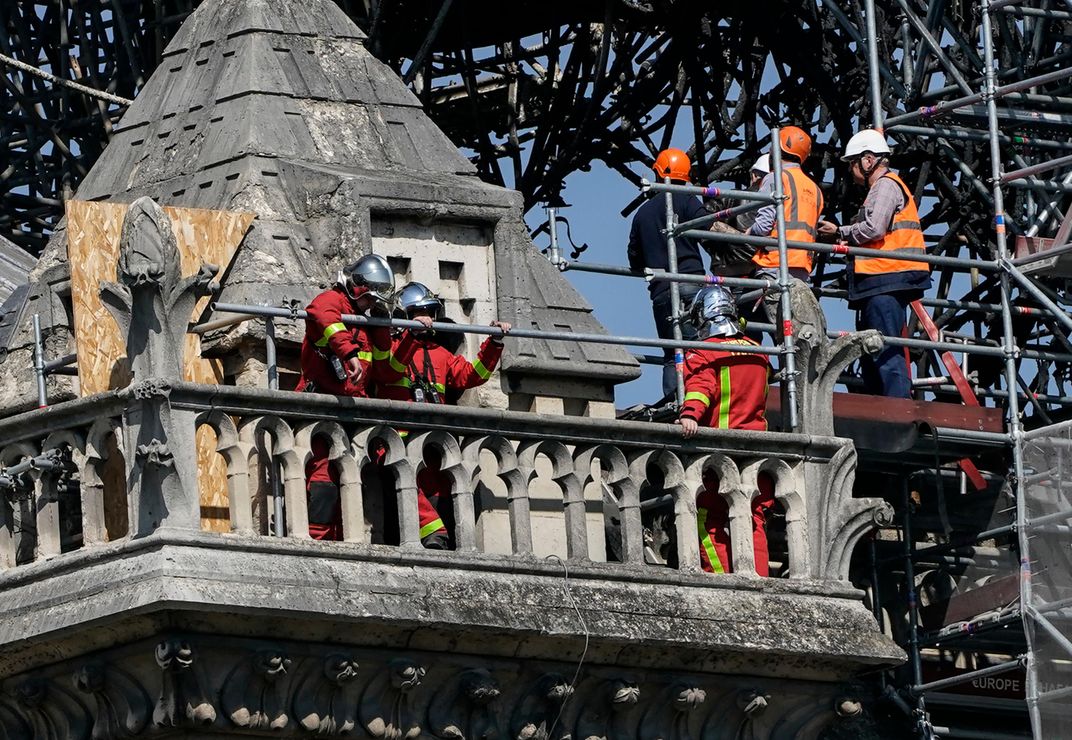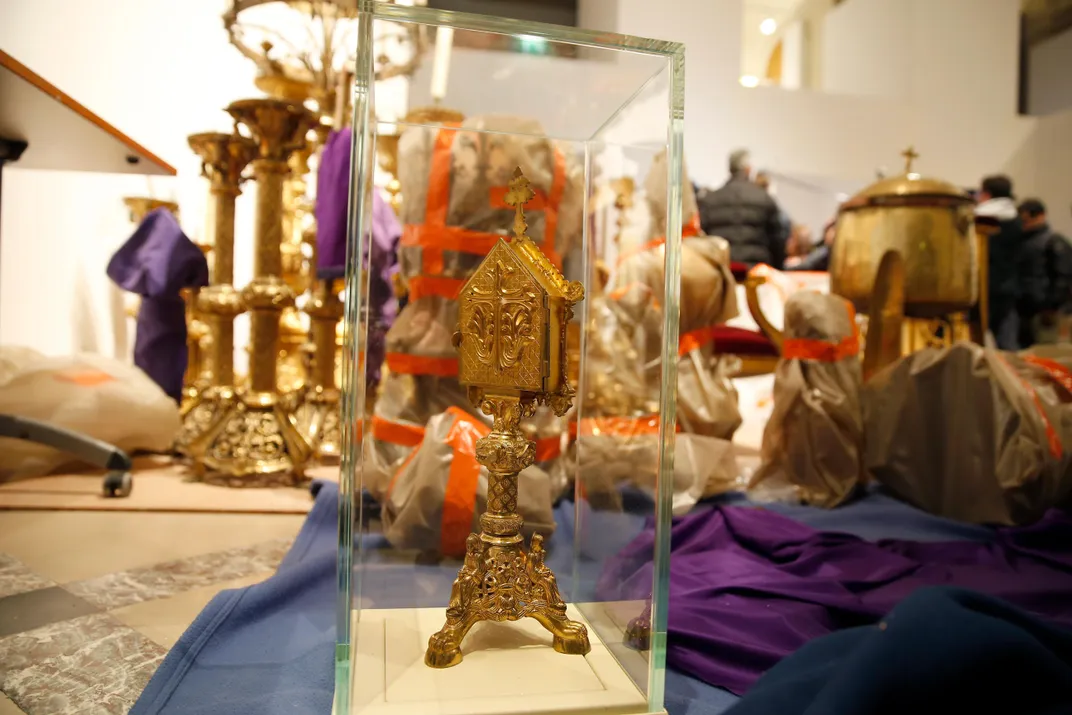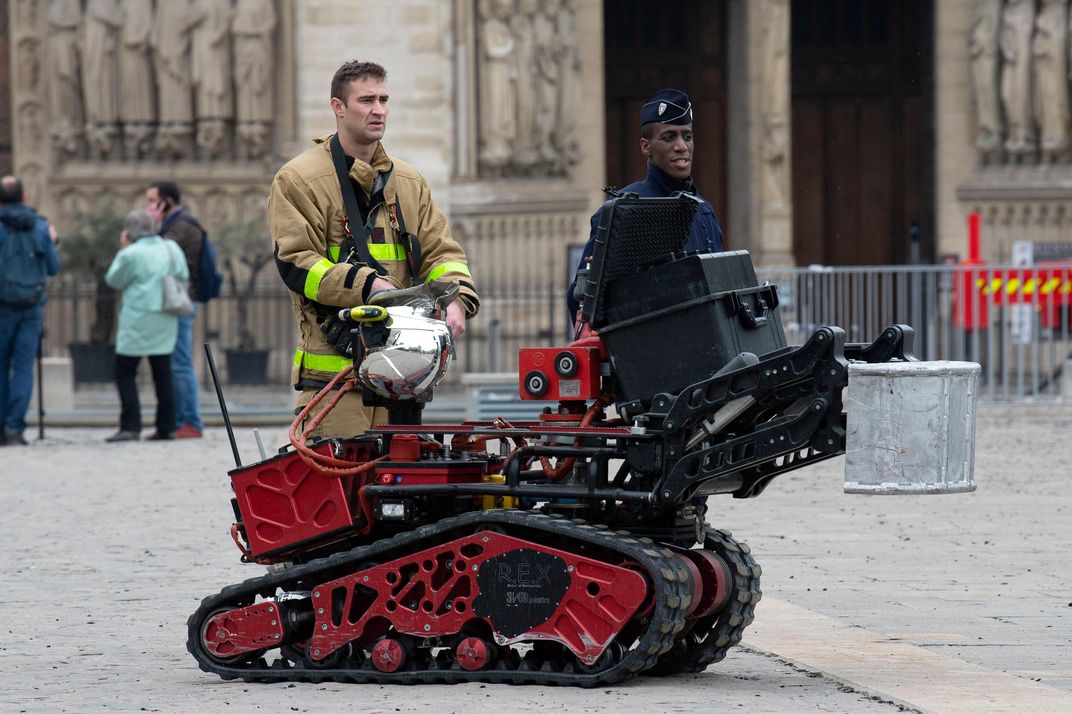Five Things We’ve Learned in the Aftermath of the Notre-Dame Fire
Here’s how France is rebuilding in the wake of the disaster
/https://tf-cmsv2-smithsonianmag-media.s3.amazonaws.com/filer/eb/ab/ebab5721-65ca-40ee-aaff-1ab599392aff/gettyimages-1137687811.jpg)
At 6:20 p.m. on Monday, April 15, an alarm interrupted mass at Paris’ Notre-Dame Cathedral. But for nearly half an hour, evacuated worshipers and tourists believed it had been a false alarm. Then, a second alarm sounded, and visible flames started flickering across the scaffolding surrounding the Gothic church’s iconic spire. At 7:49 p.m., the 295-foot, lead-covered wood tower collapsed. The cathedral’s wooden roof soon followed.
Within just “15 to 30 minutes” of complete destruction, firefighters were able to largely quell the flames. By the end of the night, they’d saved the “structure of Notre-Dame … in its entirety,” preserving the Parisian landmark’s twin bell towers and extinguishing the flames entirely.
While the cause of the fire and exact fate of many of its architectural features and artifacts remain unknown, this is what we’ve learned in the wake of the disaster:
The inferno claimed Notre-Dame’s spire and two-thirds of its wooden roof, but most major religious relics and works of art—including the Crown of Thorns, a tunic worn by King Louis IX, copper sculptures of 16 Biblical figures and three stained glass rose windows—escaped the flames. Authorities told Reuters “some five to 10 percent” of the cathedral’s artwork was likely destroyed, but the extent of damage to objects such as the Great Organ, the bells made famous by Victor Hugo’s Hunchback of Notre-Dame, and paintings dating to the 17th and 18th centuries remains unclear.
Among the most significant losses are the church’s spire, which was designed by French architect Eugène Emmanuel Viollet-le-Duc in 1859, and its 13th-century attic, which The New York Times describes as a highly flammable “forest” of lattice wooden beams. Aerial footage taken after the fire revealed several large holes in the vaulted ceiling beneath this wooden frame, while photographs of the interior showed mounds of debris littering the cathedral’s floor. Although structurally sound, according to the Washington Post, the vault and gable of the north transept remain points of vulnerability.

A metal rooster perched atop the cathedral’s spire sustained significant damage as the structure toppled over but was located amid the debris and appears to be in a “restorable” state. The status of three relics stored inside the spire topper (including a thorn reputedly from the crown worn by Jesus during the crucifixion) remains unclear. As journalist Doreen Carvajal reports for The New York Times, 16 copper sculptures depicting the Twelve Apostles and four New Testament evangelicals were removed from their normal places alongside the rooster just days before the Monday fire. Experts were scheduled to restore the statues, which have turned green from the elements, back to their natural brown color. This process will now be delayed until more time-sensitive tasks, such as repairing damage to Notre-Dame’s gargoyles, can be completed.
Jean-Francois Martins, Paris’ deputy mayor for tourism and sports, told CBS News that individuals on the scene formed a “human chain” to retrieve the relics stored inside of the cathedral as quickly as possible. In a tweet, Anne Hidalgo, the mayor of Paris, thanked the members of this link for successfully rescuing the Holy Crown of Thorns, which was acquired by France’s King Louis IX in 1238, and a tunic that king, who was posthumously canonized as Saint Louis in 1297, once wore. Father Jean-Marc Fournier, chaplain of the Paris Fire Department, personally saved the “consecrated hosts” Catholics consider to represent the body and the blood of Christ.
Notre-Dame’s trio of 12th- and 13th-century stained glass windows appear to have survived the blaze relatively unscathed. “It seems they have not been destroyed for now, although we’ll have to see what real state they’re in, and whether they can be restored properly,” Maxime Cumunel, secretary general of France’s Observatory for Religious Heritage, told Reuters’ Sarah White and Elizabeth Pineau. The 8,000-pipe Great Organ, complete with 12 pipes dating to before the 1730s, was not burned, but it is unclear whether the instrument sustained water damage and will need to be restored. Notre-Dame’s largest bell, the 13-ton Emmanuel (notably, the church’s only bell to survive the French Revolution), also escaped the flames.
According to Reuters, four large-scale 17th- and 18th-century paintings depicting scenes from the lives of the apostles were damaged by smoke and are being transferred to the Louvre to undergo restoration.
About 500 firefighters (and a 1,100-pound robot) battled the blaze, which raged for 12 hours. Authorities are investigating the origins of the inferno, but the leading theory is that the fire started accidentally, perhaps in connection with an electrical short-circuit.
On Thursday, a French judicial police official told the Associated Press that investigators, who are currently interviewing construction workers and security staff, believe an electrical short-circuit was the most likely cause of the fire, which appears to have broken out accidentally.
“At this stage, nothing in the investigations highlights a criminal origin,” the prosecutor’s office said. “Accidental causes remain our privileged lead.”
Notre-Dame’s centuries-old design, as well as a lack of basic safety measures such as fire-resistant walls and a sprinkler system, exacerbated the fire’s spread.
“These cathedrals and houses of worship are built to burn,” former New York City Fire Chief Vincent Dunn told the New York Times when the fire first broke out. “If they weren’t houses of worship, they’d be condemned.”

But the damage could have been far worse. As Paris Fire Brigade commander Jean-Claude Gallet explains in an interview with The Times’ Adam Sage, Colossus, a 1,100-pound robot equipped with a motorized water cannon capable of releasing more than 660 gallons per minute, played a key role in putting out the blaze. Not only was Colossus able to reduce the temperature in the nave of the church, but it was also capable of reaching areas its human counterparts could not.
Speaking with the Guardian’s Kim Willsher, Laurent Nunez, a junior interior minister, said the fate of the cathedral came down to just a 15- to 30-minute window. At 9:40 p.m., firefighters had expressed concerns that they would not be able to prevent the fire spreading to the north belfry, but by 10:55 p.m., Nunez was able to announce that the “edifice has been saved.” The fire was completely extinguished by 9:30 a.m. the following day.
Billionaires, companies and philanthropic foundations led donations, which raised $1.1 billion toward rebuilding efforts within just 24 hours of the fire. But the massive influx of funds has attracted ire from those who argue the money could be better spent on social programs and less publicized cultural heritage landmarks at risk of destruction, particularly in non-Western regions.
Donations poured in amid news of the fire, with companies ranging from Apple to L’Oreal and Disney, as well as individual donors including France's two wealthiest men, François-Henri Pinault, CEO of Kerin, and Bernard Arnault, CEO of LVMH Group, pledging generous financial support. By Wednesday, broadcaster BFM Paris reported, donations were set to exceed $1.1 billion.
The speed and scale with which this money materialized has proven controversial. As the Telegraph’s James Rothwell and Henry Samuel report, the cash flow arrives at a polarizing point in France’s history: “There is growing anger ... over the inertia of big corporations over social misery while they are showing themselves capable of mobilizing a crazy amount of cash overnight for Notre Dame,” stated Ingrid Levavasseur, a founding member of the Yellow Vest movement.
The steady flow of donations is all the more striking in comparison with the relatively slow trickle of funds for other disasters: The Washington Post’s James McAuley cites the United Nation’s February appeal for $4 billion in aid for Yemen (the call has only raised $2.6 billion to date), while the Huffington Post’s Mike Stuchbery reports that following the July 2017 Grenfell Tower fire, which killed 72 people and left hundreds more homeless, “micro-donations from the general public” constituted much of the roughly $26 million raised in support.
“Notre Dame offers a striking contrast,” McAuley writes. “No one was killed, no one is starving, but philanthropists likely provided the full amount—if not more—instantaneously and unprompted.”

In a tweet, journalist Simon Allison linked the disaster to Brazil’s National Museum, which lost its building and the majority of its 20 million-artifact collection in a fire last September. “In just a few hours today, 650 million euros was donated to rebuild Notre Dame. In six months, just 15 million euros has been pledged to restore Brazil's National Museum,” Allison wrote. "I think this is what they call white privilege."
Notre-Dame is far from the only historic landmark at risk of disaster; as pointed out by the Washington Post’s Siobhán O'Grady, the fire that razed Brazil’s National Museum shows the damage in Paris could have been worse. While France begins the long journey toward recovery, other countries are on alert to assess how their own monuments would hold up against fire and similar threats.
Unlike the September 2018 National Museum fire, which was sparked by a faulty air conditioning unit, facilitated by inadequate safety measures and widely attributed to Brazil’s systemic neglect of its cultural institutions, the Notre-Dame blaze was more a product of medieval construction standards and, as many have speculated, renovations aimed at maintaining the cathedral’s upkeep. Vox’s Umair Irfan notes that scaffolding surrounding the spire, as well as power tools, electric lamps and welding equipment used during construction, posed a significant fire hazard, likely fanning the flames after they broke out. Still, Adam Taylor and Emily Tamkin explain for the Washington Post, a deliberate architectural technique adopted by medieval builders—namely, constructing churches’ roofs out of wood but their walls and underlying structures out of stone—helped firefighters contain the blaze, preventing it from spreading too far beyond the cathedral’s flammable oak structures.
This isn’t the first time disaster has targeted cultural institutions or landmarks: Taylor and Tamkin cite Old St. Paul’s Cathedral, damaged during London’s Great Fire of 1666, and Ireland’s St. Mel’s Cathedral, which was destroyed in a fire on Christmas Day 2009. More recently, Smithsonian.com reported in the aftermath of the Brazil fire, a 2016 inferno gutted the National Museum of Natural History in New Delhi, and a 2015 blaze razed the Museum of the Portuguese Language in Sao Paulo. In June 2018, a particularly devastating fire broke out at Scotland’s Glasgow School of Art, erasing all traces of the nearly complete $46 million-restoration launched following an earlier blaze in 2014.
As France begins to assess rebuilding options, countries across the world are turning attention to their own national heritage sites—many of which are poorly equipped to face natural disasters. “All medieval buildings are at risk,” Susan Corr, president of the European Confederation of Conservator-Restorers' Organisations, tells NBC News’ Rachel Elbaum. “They all have wood. How they are taken care of, who updates them, and at what point conservation becomes a copy are questions we are constantly dealing with.”
Britain’s Houses of Parliaments, scheduled to undergo renovation in the mid-2020s, are a key locus of concern. And, following the Notre-Dame fire, London’s Westminster Abbey, Canterbury Cathedral and Dublin’s St. Patrick’s Cathedral all reminded visitors of existing fire protocol, with the first posting a statement to Twitter: “Notre Dame’s internal structure was wood whereas Westminster Abbey is mainly composed of stone. But should the worst happen, we have preparations in place to save our 750-year-old building.”
Across the pond, experts emphasized the fact that America’s churches and landmarks are centuries newer than Europe’s, making them more likely to have functional modern fire prevention systems. Speaking with USA Today’s Deirdre Shesgreen, park ranger Adam Duncan said, “Sprinklers, alarms, pretty much anything that you would find in a modern office building, you would find at Independence Hall.”
French President Emmanuel Macron has set a goal of rebuilding Notre-Dame, making it “more beautiful than before” within five years. Experts say this timeline is unrealistic, suggesting the process will take a minimum of 10 to 20 years, with some estimates standing at closer to 40 years or more. Among other rebuilding efforts, the country has announced plans for a competition to redesign the cathedral’s fallen spire and proposed the creation of a temporary wooden church outside of the closed house of worship.
Emily Guerry, a medieval historian from England’s University of Kent, tells CBS News’ Haley Ott the rebuilding process will begin by “assessing the damage, strengthening everything that's there, [doing] a full inventory of what we've lost, and then [finding] the building materials.” Immediate concerns include protecting the caved-in structure from the elements with a temporary metal or plastic roof, as the Associated Press’ Jill Lawless and Raf Casert report, and securing the cathedral without disturbing the debris littered across its floor.
A major question moving forward is whether Notre-Dame will be restored in accordance with its pre-fire form—a viable option given the exhaustive documentation offered by a digital replica created with 3-D laser scanning—or updated to incorporate modern materials, techniques and designs.
If rebuilt exactly as it stood just last week, Notre-Dame’s roof, consisting of some 13,000 wood beams, will require around 3,000 sturdy oak trees to replace in its entirety. Just 4 percent of Europe’s remaining woodland is categorized as primary forests today, but Guerry, the historian, says there may be enough “very tall, old trees” in the Baltic, which provides much of the continent's oak. The original stone used to build the French landmark was quarried and assembled by hand during the 12th century; Guerry adds that new limestone procured will have to go through that same system of quarrying by hand “to create [a] homogeneous effect."
On Wednesday, Prime Minister Édouard Philippe announced plans to host an international competition aimed at replacing Notre-Dame’s fallen tower with a “new spire suited to the techniques and challenges of our time.” Speaking to reporters, Philippe said the contest will allow France to decide whether it wants to recreate the spire exactly as it was designed in 1859 or, “as is often the case in the evolution of heritage,” update the cathedral with a new look—a proposal that already proven divisive.
In an interview with France’s CNews television channel, Notre-Dame's chief priest, Monseigneur Patrick Chauvet, urged viewers not to think of the cathedral as closed. “Can I not build an ephemeral cathedral on the esplanade [in front of Notre-Dame]?” Chauvet said.
Details for this makeshift wooden structure are still in the works, but the mayor has offered her support for the idea. If all goes according to plan, the surrogate “cathedral” will be built as soon as the esplanade reopens.
This isn’t the first time Notre-Dame has faced seemingly insurmountable disaster, and it likely won’t be the last. But if there is one common theme across the Parisian landmark’s chaotic history, it’s endurance. “The fire at Notre Dame reminds us that our history never stops and we will always have challenges to overcome,” President Macron said in a Tuesday address to the nation. “We will rebuild Notre Dame, more beautiful than before,” he continued. “We can do it. After the time of testing comes a time of reflection and then of action.”
/https://tf-cmsv2-smithsonianmag-media.s3.amazonaws.com/accounts/headshot/mellon.png)
/https://tf-cmsv2-smithsonianmag-media.s3.amazonaws.com/accounts/headshot/mellon.png)